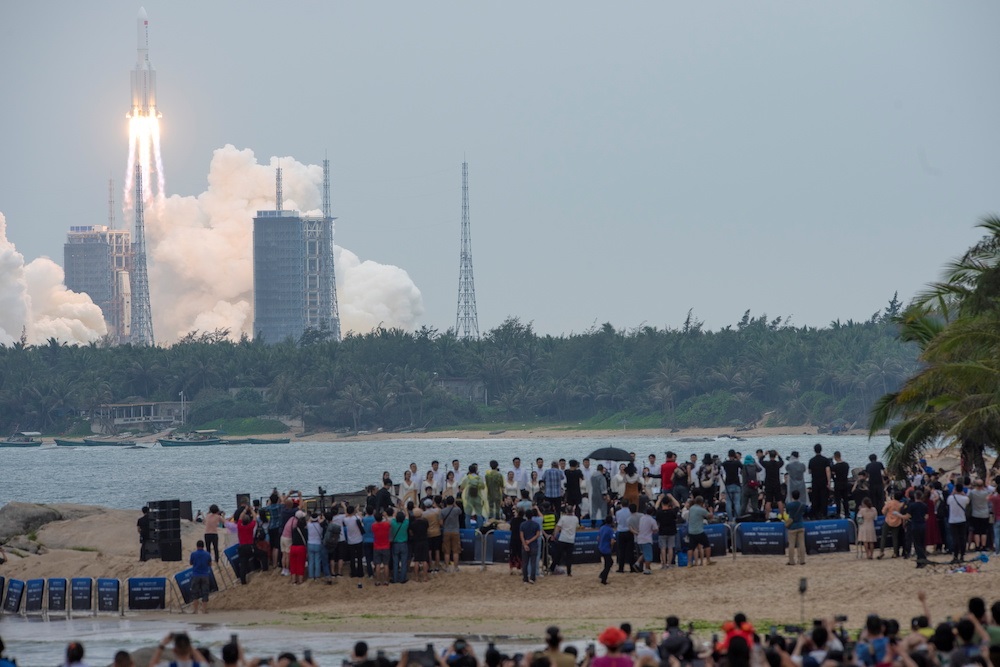
People watch from a beach as the Long March-5B Y2 rocket, carrying the core module of China’s space station Tianhe, takes off from Wenchang Space Launch Center in Hainan province, China April 29, 2021.
SHANGHAI: Remnants of China’s largest rocket launched last week are expected to plunge back through the atmosphere in the coming hours, European and US tracking centres said today.
While there were still varying estimates of where the rocket would land, it appeared increasingly likely it would not hit the United States.
China’s foreign ministry said yesterday that most debris will burn on re-entry and is highly unlikely to cause any harm, after the US military said that what it called an uncontrolled re-entry was being tracked by US Space Command.
US Space Command estimated re-entry would occur at 0211 GMT today, plus or minus one hour, while the Centre for Orbital Reentry and Debris Studies (CORDS) at Aerospace Corporation, a US federally funded space-focused research and development centre, updated its prediction to two hours either side of 0302 GMT with the rocket re-entering over the Pacific.
EU Space Surveillance and Tracking (EU SST) said its latest prediction for the timing of the re-entry of the Long March 5B rocket body was 139 minutes either side of 0232 GMT today.
EU SST said the statistical probability of a ground impact in a populated area is “low”, but noted that the uncontrolled nature of the object made any predictions uncertain.
Space-Track, reporting data collected by US Space Command, estimated the debris would make reentry over the Mediterranean Basin.
Harvard-based astrophysicist Jonathan McDowell said on Twitter that it was believed the United States was safe from a potential impact but recent predictions were still tracking it from Costa Rica all the way to Australia and New Zealand.
Travelling at a speed of around 4.8 miles per second, a difference of just one minute in the time of reentry translates to hundreds of miles difference on the ground.
“This is difficult to predict and not an exact measurement,” Space-Track wrote on Twitter.
More Missions to Come
The Long March 5B ― comprising one core stage and four boosters ― lifted off from China’s Hainan island on April 29 with the unmanned Tianhe module, which contains what will become living quarters on a permanent Chinese space station. The rocket is set to be followed by 10 more missions to complete the station.
Long March 5 rockets have been integral to China’s near-term space ambitions – from the delivery of modules and crew of its planned space station to launches of exploratory probes to the Moon and even Mars.
The Long March launched last week was the second deployment of the 5B variant since its maiden flight in May last year.
McDowell previously told Reuters there is a chance that pieces of the rocket could come down over land, perhaps in a populated area, as in May 2020, when pieces from the first Long March 5B fell on Ivory Coast, damaging several buildings. No injuries were reported.
Debris from Chinese rocket launches is not uncommon within China. In late April, authorities in the city of Shiyan, Hubei Province, issued a notice to people in the surrounding county to prepare for evacuation as parts were expected to land in the area.
“The Long March 5B reentry is unusual because during launch, the first stage of the rocket reached orbital velocity instead of falling down range as is common practice,” the Aerospace Corporation said in a blog post.
“The empty rocket body is now in an elliptical orbit around Earth where it is being dragged toward an uncontrolled re-entry.”
The empty core stage has been losing altitude since last week, but the speed of its orbital decay remains uncertain due to unpredictable atmospheric variables.
It is one of the largest pieces of space debris to return to Earth, with experts estimating its dry mass to be around 18 to 22 tonnes.
The core stage of the first Long March 5B that returned to Earth last year weighed nearly 20 tonnes, surpassed only by debris from the Columbia space shuttle in 2003, the Soviet Union’s Salyut 7 space station in 1991, and NASA’s Skylab in 1979.

